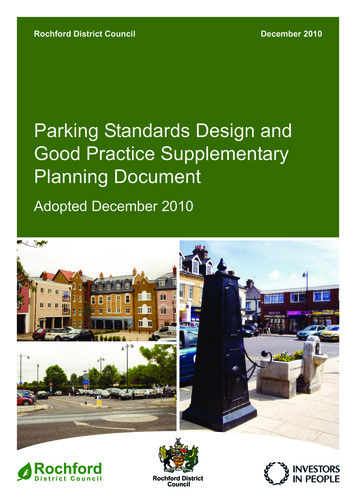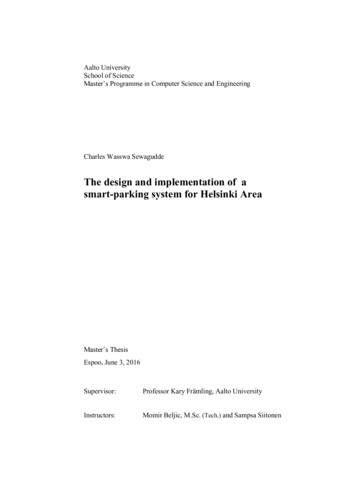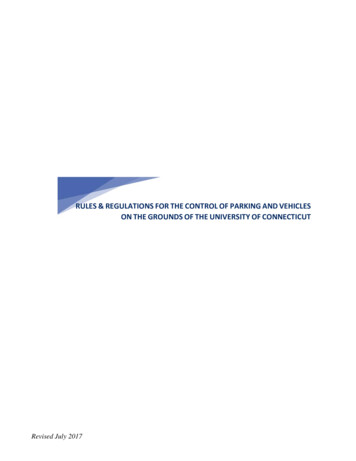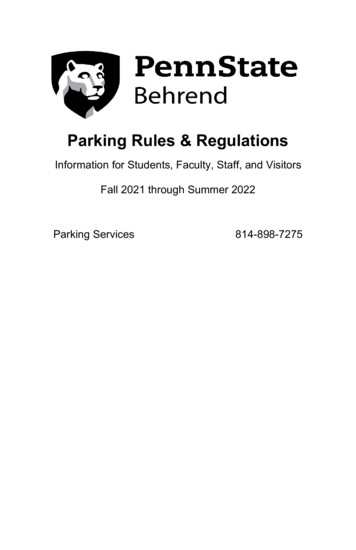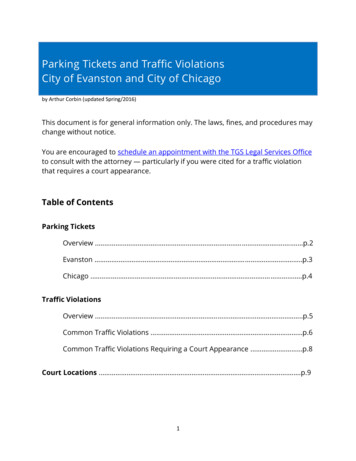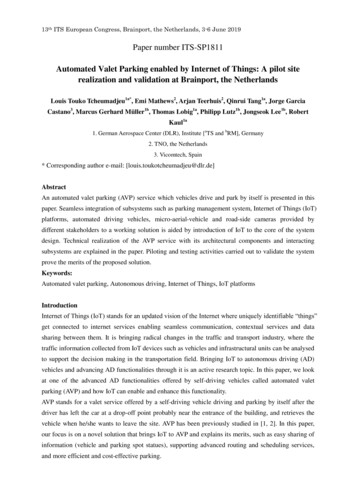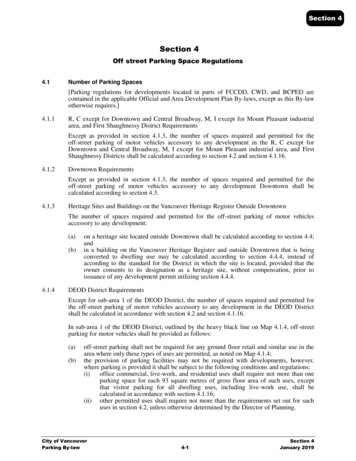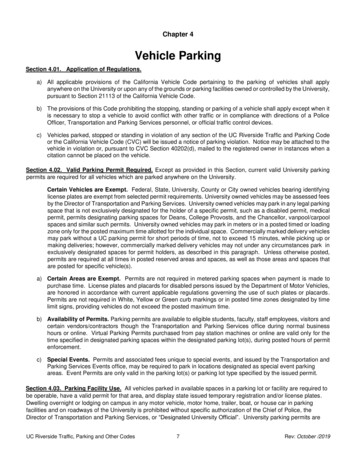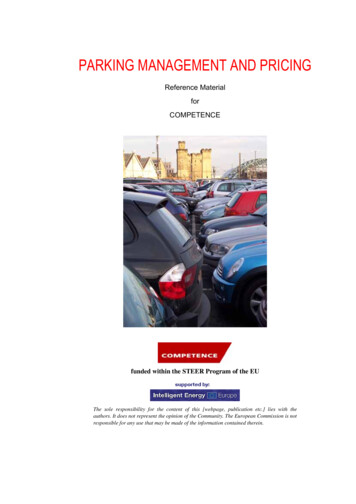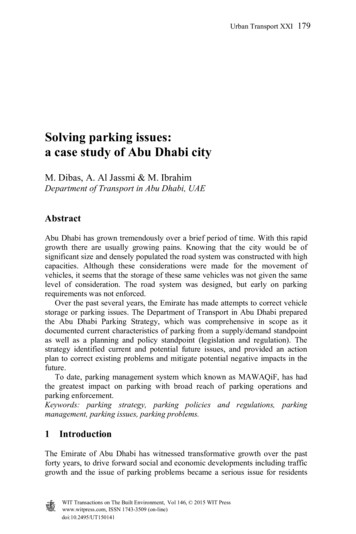
Transcription
Urban Transport XXI179Solving parking issues:a case study of Abu Dhabi cityM. Dibas, A. Al Jassmi & M. IbrahimDepartment of Transport in Abu Dhabi, UAEAbstractAbu Dhabi has grown tremendously over a brief period of time. With this rapidgrowth there are usually growing pains. Knowing that the city would be ofsignificant size and densely populated the road system was constructed with highcapacities. Although these considerations were made for the movement ofvehicles, it seems that the storage of these same vehicles was not given the samelevel of consideration. The road system was designed, but early on parkingrequirements was not enforced.Over the past several years, the Emirate has made attempts to correct vehiclestorage or parking issues. The Department of Transport in Abu Dhabi preparedthe Abu Dhabi Parking Strategy, which was comprehensive in scope as itdocumented current characteristics of parking from a supply/demand standpointas well as a planning and policy standpoint (legislation and regulation). Thestrategy identified current and potential future issues, and provided an actionplan to correct existing problems and mitigate potential negative impacts in thefuture.To date, parking management system which known as MAWAQiF, has hadthe greatest impact on parking with broad reach of parking operations andparking enforcement.Keywords: parking strategy, parking policies and regulations, parkingmanagement, parking issues, parking problems.1 IntroductionThe Emirate of Abu Dhabi has witnessed transformative growth over the pastforty years, to drive forward social and economic developments including trafficgrowth and the issue of parking problems became a serious issue for residentsWIT Transactions on The Built Environment, Vol 146, 2015 WIT Presswww.witpress.com, ISSN 1743-3509 (on-line)doi:10.2495/UT150141
180 Urban Transport XXIand businesses. In 2009, the Department of Transport (DoT) published the 2030Abu Dhabi Surface Transport Master Plan (STMP) to develop the transportaspects of Plan 2030. Effective parking management and development controlformed a key part of the Congestion Management Strategy set out in the plan.For Abu Dhabi Island, in 2009, parking and land use surveys were completedin 46 sectors predominantly in the CBD (approximately 152 sectors on AbuDhabi Island) where parking congestion had been observed.The parking survey indicated that in some sectors the parking demand wasmuch higher than the available spaces for on-street parking. This formed thebasis for the estimation of parking shortfalls and recommendation of actions toincrease the parking supply and reduce parking demand.Two methods were applied for the estimation of the parking demand:1.1 Method 1: parking survey dataThe parking surveys in the 46 sectors provided the number of parked vehicles,legal and illegal, at several times of the day. This measured and revealed theutilization of parking spaces and was considered to reflect the real demand.1.2 Method 2: land use based parking demand calculationsThis method used the applicable DoT parking demand rates for various land usesto estimate the parking demand. The two inputs to this method are the parkingrates and the land use intensities according to the 2012 Abu Dhabi TripGeneration and Parking Rates Manual (ADTGM).2 Appraisal of historical problemA clear understanding of the historic parking supply issues and current demandfor parking is an essential foundation for the Parking Strategy. This sectionincludes an overview of the historic problems and associated impacts.As illustrated in Figure 1 the problems stem in part from supply issuesresulting from the historical plot sizes allocated to developers and in part fromlack of parking management.From the supply side, many high-rise buildings (20 floors) have beenpermitted to be constructed on plots typically measuring 24m x 20m or less, withthe following impacts: Basement car parks are difficult to construct due to size limitations andseveral floors are required to meet demand. Due to high water tablelevels it has been generally accepted that 2 to 3 basement levels is areasonable provision as additional levels are too costly; Difficulty in providing required gradients and meeting other designcriteria for vehicle circulation; and High capital and maintenance costs of automated parking, which has thepotential to partially mitigate the problem, has been consideredprohibitive.WIT Transactions on The Built Environment, Vol 146, 2015 WIT Presswww.witpress.com, ISSN 1743-3509 (on-line)
Urban Transport XXIFigure 1:181Historic parking problem diagram.Therefore, significant difficulties were encountered with supplying parkingunderground. Moreover, the historic development code used did not allow theabove ground floors to be used for parking. As a result of the above and inthe absence of clear enforcement and regulation of providing parkingrequirements, many buildings were exempted from providing parking facilities.In addition to this structural parking deficit there were several parkingmanagement issues that have exacerbated the parking problem including: Lack of adequate enforcement of land use policy often creates parkingproblems within Abu Dhabi. For instance, the conversion of residentialtowers into commercial office space without proper authorization hasresulted in severe parking shortages; Division and sub-division of housing ‘units’ effectively multiplying thenumber of people per household; Certain businesses, such as rental car companies, occupy the existingsurface parking lots for extended periods of time; Misuse of private off-street parking by private renting rather thanassignment it to the building tenants. This is an indication of thepropensity to unbundle parking from the rental of property. This isrequires further study as part of the strategy action plans; Irregular on-street parking resulting from un-marked parking bays/ lotswithin specific sectors; Abandoned vehicles, (written off after accidents or whose owners haveleft the country), scrap and trolleys occupying or stored on markedparking areas; Over-concentration of land-uses within one district or sector, e.g., theprivate school zone and the government agencies in the civic centre,which creates a huge demand for parking facilities; and Land-use planning not being utilized to address problems throughmixed use shared parking concepts.WIT Transactions on The Built Environment, Vol 146, 2015 WIT Presswww.witpress.com, ISSN 1743-3509 (on-line)
182 Urban Transport XXIOn 20 October 2009, Law No. 18 formally assigned the responsibility forparking management to the Department of Transportation. DoT had begunactivities related to parking management during the first half of 2009 andestablished MAWAQiF as the division for the parking management program.3 Achievements to dateSignificant achievements have been made to manage the parking system withinAbu Dhabi since 2009 after Law 18 was issued to transfer parking managementto DoT. Some of the key benefits of the implementation of MAWAQiF include: Roll out of several sectors in Abu Dhabi with increased parking supplywithin some of the sectors; Improved access, circulation and parking layout changes; Better provisions of turnaround facilities for vehicles; Improved safety for vehicles / pedestrians; Improved accessibility for emergency vehicles; Improved pedestrian mobility, raised pedestrian crossings, trafficcalming measures and handicap access and parking provisions; Improved ingress and egress to/from parking areas; Various parking restrictions applied and issuance of illegal parkingviolations; Disabled parking spaces are being provided as needed; Spaces for Civil Defense, Ambulance and taxis are provided; System is in place to handle requests from construction companies; Enforcement through towing and storage of abandoned vehicles is ineffect; Inspectors are deployed to enforce regulations; Permits for residential and commercial uses are issued; Efforts made to monitor and enforce supply of parking in existingbuildings; and Multiple convenient payment methods exist for payment of parkingfees.As of early 2014 the total number of on street surface parking bays in the AbuDhabi Island is 102,981 spaces from 95,504 bays in 2009.4 Stakeholder engagement and feedbackThe key role that parking plays in the urban fabric of any city as a land use aswell as part of the transport system calls for interactions with a variety ofGovernment and private stakeholders to facilitate the development process of aParking Strategy that will be embraced by all. As such, the Parking Strategy hasbeen informed by an extensive programme of internal and external stakeholderengagements.Twelve stakeholder groups were represented in the two rounds of consultationprocess in the development of the Parking Strategy. The stakeholderWIT Transactions on The Built Environment, Vol 146, 2015 WIT Presswww.witpress.com, ISSN 1743-3509 (on-line)
Urban Transport XXI183engagements were aimed to identify current parking problems and possiblesolutions and objectives to inform the development of the Parking StrategyReport. The majority of the stakeholders acknowledged that parkingmanagement – MAWAQiF, should be a component of the overall TransportMobility Management (TMM) within a city, and more coordination betweenMAWAQiF, Abu Dhabi Urban Planning Council (UPC), and other publictransportation elements is required. There is also a need for government-levelsupervision of the entire public transport system and the multi-billion dirhamplanned public transport investments to ensure that parking supply and otherindividual components are not being optimized at the expense of the overallsystem.5 Policies and regulationsIn relation to world practice benchmarking, Table 1 (source of data except AbuDhabi: Rye [1]) represents how different cities around the world approachparticular aspects of parking policies. Key aspects from the table include: Most cities have developed some form of on street parking regulation; A number of cities have developed parking standards for new buildings; Parking guidance systems (ITS) have recently been implemented acrossmany European and North American cities;Abu Dhabi is arguably catching up with the world’s best practices in regardsto policy and planning and the following points present a summary for eachpolicy that will empower better managed, well enforced and effective parkingstrategies.5.1 Abu Dhabi parking law and regulationsParking Law 18 (2009), the umbrella parking law, empowers DoT to regulate,manage and enforce all public parking. It also provides the basis for regulatingand enforcing the parking supply in new and existing developments as part of theDoT Transportation Impact Study (TIS) review and approval process. CurrentlyDoT uses the 2012 Abu Dhabi TIS Guidelines and the 2012 Abu Dhabi TripGeneration and Parking Rates Manual (ADTGM). The stakeholder discussionsrendered that Parking Law 18 provides significant improvement to parkingregulation in Abu Dhabi.5.2 Department resolutions and policiesSince the implementation of the DoT, there have been a number of resolutionsthat have been applied. Stakeholders agreed that the strategy should not exist inisolation, as a number of concerns were raised regarding the lack of connectivitybetween the Parking Strategy and other strategies, Abu Dhabi 2030 Vision andthe Strategic Transport Master Plan. Stakeholders and committees should workin harmony to achieve the sustainability goals. Overall, the previous circulars,executive council resolutions and policies need to be combined and aligned withthe Abu Dhabi 2030 vision.WIT Transactions on The Built Environment, Vol 146, 2015 WIT Presswww.witpress.com, ISSN 1743-3509 (on-line)
184 Urban Transport XXIParisLondonSan FranciscoChicagoLos AngelesNew YorkAbu DhabiOn-street parkingregulationOff-street parkingregulationSydneyWorld approach towards parking policies.SingaporeRegulationTable 1: Limits for maximumlength of stayPlanningEconomicincentivesImproved enforcement Off-street parkingpricing Smart pricing Dedicated residentialparking areas Park and ride facilitiesParking guidance systemOthers On-street parking pricingMaximum parkingstandards for newbuildings Evaluation of supply anddemand for parkingfacilities 5.3 Development right (Development Code) and future parking demandThe Development Code has a significant impact on the parking demand andsupply. The Executive Council issued a decree on approval of plots in terms ofparking supply and demand setting the minimum demand to be met by thedeveloper to be 70%, however developments could be reviewed on a case-bycase basis. A study of the impact of the Development Code on parking and othersectors noted a large discrepancy between the Parking Strategy and DevelopmentCode parking demand numbers. It was agreed that regulating developments in ameticulous manner with foresight of urban growth would help alleviate parkingissues. It is necessary to investigate which land uses and sectors are ideal forWIT Transactions on The Built Environment, Vol 146, 2015 WIT Presswww.witpress.com, ISSN 1743-3509 (on-line)
Urban Transport XXI185shared parking and agree upon a reduction. Further, a cap and bank system forparking regulation on new developments should be investigated in Abu DhabiCBD.5.4 PermitsCurrently, MAWAQiF administers parking permits and, with the aid of SAEED,manages parking violators. On-street parking regulations specify twoclassifications: Standard and Premium where the rates are AED 2 and 3,respectively. The resolution defined maximum time limits for premium parkingand regulated the provision of permits and reserved parking. MAWAQiF alsoregulates and operates public multi storey car parks (MSCP) as well as inspectspublic and private MSCP. MAWAQiF issues various types of permits asstipulated on the MAWAQiF website. MAWAQiF has also begun to implementan Executive Council resolution subjecting all new residential developments tofulfill at least 70% of the applicable parking rate and incur a charge of AED50,000 for each space that is not provided (cash-in-lieu). To enforce the permitviolations and other parking violations, MAWAQiF manages a tow and carpound operation. Based on the regulations in place, a fine of AED 500 fortowing and a daily charge of AED 100 for storage are applied to violators. It isnecessary to continue the MAWAQiF rollout, maintain the residential parkingpermit program and investigate the impact of price increases.5.5 Abandoned vehiclesAbandoned vehicles are unsightly, take up space, and attract vandalism andcrime. A strategy needs to be developed in order to remove and appropriatelydiscard these vehicles. Currently the Abu Dhabi Municipality deals withabandoned vehicles. After a vehicle is identified as abandoned the municipalityinspector monitors the vehicle for 14 days, at which point a 24 hour notice is lefton the vehicle. If the vehicle is not removed, it is then towed to a storage yard.The UAE practices different means to discard including, selling of parts,auctioning the vehicle, or destroying it. Dedicated areas should be identified forstorage of abandoned vehicles. Beyond that, a strategy should be developed todetermine whether the vehicle is to be returned to the owner, sold in an auction,or destroyed.5.6 Parking space reservation policy (temporary or permanent)MAWAQiF is the designated authorization of parking space reservation policy.This service is provided to entities that reserve parking according to thecategories defined by the scheme for banks, hotels, political and diplomaticbodies, hospitals and construction companies for projects, ministries andgovernment departments, or any other category that may be so defined. Residentpermit holders can use resident parking areas as per the timing displayed onMAWAQiF signs. This also helps residents find parking easier. Areas designatedWIT Transactions on The Built Environment, Vol 146, 2015 WIT Presswww.witpress.com, ISSN 1743-3509 (on-line)
186 Urban Transport XXIfor residents can be easily identified through MAWAQiF signage marked with“Resident Permit Only".5.7 Parking rateAbu Dhabi Parking Strategy was based on the 2009 parking rates, which weredeveloped from parking surveys in the year 2008. However, any new survey orassessment will be based on the Abu Dhabi Trip Generation and Parking RatesManual (ADTGM) developed from the comprehensive parking surveys carriedout in 2012. The stakeholder discussion outlined the parking requirements andrates needed to be looked at with respect to different land uses and the masterplan for the area. It was considered that one flat rate could not apply everywhereand that there was a need to understand the impact of parking provision in anarea and the changing land uses taking place within these areas. The key todetermining applicable parking rates is to consider the governing factors such asaccessibility to parking and alternative modes of travel. Also, a number ofstakeholders questioned whether it was necessary for each land use in a block tohave its own parking. There were suggestions that a maximum parking provisionbe implemented rather than the current minimum. To improve the parking rates,residential, office and retail rates should be re-evaluated. Many large globalcities allow for significant reductions where justifiable and usually as a result ofquality public transportation. While BRT, LRT and metro services are notcurrently operational in Abu Dhabi they should be considered in theirdevelopment and in future parking rates.5.8 Car ownershipHigh car ownership rates are perceived as having a significant impact on parkingand congestion in Abu Dhabi. Stakeholders recognized in the discussion thatownership rates are particularly high, given a history of low public transportservices, low petrol costs and a comparatively cheap cost of cars in an affluentsociety. It was agreed on that a high-level car ownership policy needed to restrictcar ownership.5.9 Land use and mixArguably having one of the largest impacts on parking supply and demand is theallocation of particular land uses in proximity of each other and to publictransport. Currently, Abu Dhabi Island is a mix of residential, commercial,schools and retail among other land uses. Previously, there was no considerationinto how land use should be planned throughout the Emirate, however, since theintroduction of Abu Dhabi Urban Planning Council (UPC), the approach is moreorganized and well envisaged with the ability to future proof what land useshould be adjacent to high quality public transport. The 2012 Parking Strategyvery briefly discusses the role of land use and mix despite this being the majorcontributor to the parking issues experienced across the Emirate. The importanceof land use mix is essential to encourage public transport use in the futureWIT Transactions on The Built Environment, Vol 146, 2015 WIT Presswww.witpress.com, ISSN 1743-3509 (on-line)
Urban Transport XXI187scenario with BRT, LRT and Metro and should be examined individually for anyland use plan. To improve sustainability in the Emirate and to sufficientlysupport the development of LRT/BRT, land uses and minimum densities shouldbe investigated to determine appropriate developments be considered in closeproximity to the public transport. Further investigate “activity areas” for sharedparking and non-private car streets to encourage cycling, walking and publictransport.5.10 Public transport impactPublic transport is becoming an increasingly funded domain for transportation inAbu Dhabi. A key element of Parking Strategy is to allow for a smoothtransition, from a car dominated society to one with a fully integrated andcomprehensive public transport system. The DoT manages the comprehensiveand expanding bus network connecting the Emirate, and DARB, an easy-to-useeasy-to-access interactive map that provides users information on travel itinerary.The implementation of BRT, LRT and Metro remain several years away;however its continued development is essential to improve upon thesustainability of the Emirate. Public transport projects are not generallyconsidered to directly reduce car ownership, and therefore the residential parkingdemand. It is accepted that high quality multi-modal public transportation willhave some impact when combined with the right social and economic conditions.In addition, public transportation can have a significant impact on reducingprivate car trips and therefore parking requirements in non-residential land uses.Distinction between land uses is a key point to effectively utilize public transportmodes.5.11 Transport mobility managementThe overarching transport mobility management (TMM) Strategy is composed ofa number of sub-strategies that are aimed at specific target groups (workplace,education, visitor, residential). Segmentation and target group specific actionsand Transport Mobility Management measures are crucial in achieving thedesired outcomes. Each sub-strategy focuses on TMM plans for the relevanttarget groups as well as a number of stand-alone initiatives. The strategy seeks toincrease choice of transportation modes and implement sustainable traveloptions, and is essential in helping Abu Dhabi fulfill its growth potential. Parkand Ride Policy In 2011, DoT undertook a study aiming to establish “Park andRide Services” to reduce parking demand in the CBD, to reduce congestion, tominimize environmental impacts, and to improve safety, integrity, and appeal ofthe municipality. Stakeholders noted the initially low uptake of Park and Rideand correlated it to the public’s attitude towards public transport. Thestakeholders noted that Park and Ride was an interim measure before the fullpublic transport network was developed. However, a long term plan for Park andRide should be produced as a supplement for the proposed Metro services. Thelocation of park and rides should be studied to encourage the public to use theservice.WIT Transactions on The Built Environment, Vol 146, 2015 WIT Presswww.witpress.com, ISSN 1743-3509 (on-line)
188 Urban Transport XXI5.12 Freight policy and regulationsRegarding freight policy and regulations, an Emirate wide freight plan nowexists, including aspirations and objectives for the treatment of road basedfreight activities. In most industrial areas parking controls will need to beintroduced to more effectively manage the use of forecourts and road. To ensurethere are adequate parking and rest stops on major roads is a key safety measureand at border crossings, where significant parking areas are needed to take intoaccount vehicle processing delays. There are currently some formal areas forloading and unloading take place for both residential and commercial buildings.A review is necessary as adequate loading facilities are essential to goodbusiness management and for residential apartment blocks.5.13 School busesSchool buses are another factor considered in Parking Strategy. The majority ofschools within Abu Dhabi offer a dedicated bus service for pupils at school startand finishing times but the cost is relatively high. During the school day thesebuses, often up to 20, require parking within school plots or on adjacentforecourts and roads. Accessibility and safety is an issue and generally parentsare encouraged to pick-up and drop-off their children. During the stakeholderdiscussions it was determined that bus flow and parking should be separate fromthat of private cars. Buses owned by the school must comply with DoT parkingstandards and third party operators are responsible for arranging off-site parking.Physical and management safety measures need to be investigated to encouragethe use of buses.5.14 Shared parking policyImplementing a shared parking policy within Abu Dhabi is one of the keyaspects to reducing the parking shortfalls currently experienced, and assisting inoptimizing the supply of parking in the future. A shared parking policy shouldinclude both on-street and off-street, private and public car parks. To alleviatethe underutilization of parking spaces, most jurisdictions are exploring the use ofshared parking as a parking management strategy. This is most successful ofdestinations have different peak periods or, if they share the patrons. Thestrategy highlights a number of ways in which parking can be shared including:shared rather than reserved parking, sharing among different land uses andimplementing multi-use parking facilities. It is important to identify key areaswhere shared parking is feasible, to revise Law 18 to allow for developments toshare parking, and to review parking supply of adjacent streets to BRT, LRT andMetro Services.5.15 Special category parkingFinally, addressing special category parking (disabled, bicycle, motorcycle andvalet) will improve Abu Dhabi’s accessibility and promote environmentallyWIT Transactions on The Built Environment, Vol 146, 2015 WIT Presswww.witpress.com, ISSN 1743-3509 (on-line)
Urban Transport XXI189friendly modes of transport to work towards the sustainability goals. Since theimplementation of MAWAQiF, disabled parking bays are increasinglyimplemented in developments; however, they are routinely used by people whodo not have a permit. It is necessary to continue adding disabled bays (with theappropriate surrounding infrastructure) and to investigate ways to enforce lawsto maintain these bays for permit holders. Bicycle parking was encouraged bystakeholders as it occupies less space on the road and less space for parking. TheDoT has recently released the Abu Dhabi Walking & Cycling Master Plan,which indicates parking rates for bicycle parking. The Master Plan alsoidentified the importance of car parking around bicycle facilities and theimportant role it plays with encouraging people to cycle. The reason someEuropean countries have been able to encourage cycling as the main mode oftravel is not only through the excellent facilities for the journey but also the endof trip facilities, such as showers, numerous bike racks and in prominentlocations. Similar to bicycle parking and use, motorcycles are encouraged as theyutilize less space on the roads and less space for parking as well, thereforepotentially increasing capacity of the overall transportation network.6 Recommendations and key factors sustaining Abu Dhabiparking strategyThe key factors sustaining Abu Dhabi parking strategy are: Objectives – Mixed objective parking strategies are sustainable andshould be adopted as the basis for any review of the strategy; Need for Controls – Lack of parking controls is a significant cause ofparking problems rather than a lack of provision; Live Document – The Parking Strategy needs to be seen as a live,flexible document which will need to be adaptable to emerging futureneeds and issues; Historic Deficits – Focus on addressing the historic deficits on AbuDhabi Island in a sustainable manner with optimal provision ofadditional parking controls and off-street parking facilities as keyactions; Extend Controls – Extend existing controls in the CBD and completethe introduction of paid parking in other areas. Industrial Areas – Development of controls for use in the industrialareas; New Growth Areas – Introduction of new controls in all the new, higherdensity growth areas. TMM and PT Support – The use of parking controls to supporttransportation mobility management (TMM) strategies and the use ofPT and non-auto modes. This involves a reciprocal obligation and willonly be viable when public transport proposals are implemented todeliver a network that meets the needs of a global city and which offersa viable alternative mode choice to users;WIT Transactions on The Built Environment, Vol 146, 2015 WIT Presswww.witpress.com, ISSN 1743-3509 (on-line)
190 Urban Transport XXI Differential paid parking – Need to introduce parking controlsprogressively, including the use of differential paid parking rates;Special Needs – Special access needs for vulnerable road users and roadfreight;Enforcement – Need to provide a basis for comprehensive parkingenforcement within urban areas;Area treatments – Area based treatments and action plans should bereviewed and extended to meet emerging needs;Governance of strategy – Need for effective governance of the progressand performance inherent in implementing the Strategy Action Plansand continued stakeholder involvement in the successfulimplementation and evaluation of the Strategy;Improved coordination – Need to coordinate internal and externalstakeholder actionsImproved positive publicity – Creation of more positive messagingaround parking enforcement and parking facilities.The value of parking management and adequate supply of parking cannot beoverstated. Research shows that over 50% of the traffic in typical downtownareas is simply on the road, cruising around the block searching for vacant,convenient parking spaces (source: Millard-Ball [2]).Undoubtedly, the historic parking problems continue to contribute to trafficcongestion with significant adverse economic and environmental implications tobusinesses and the general public within the Abu Dhabi Island and other centresin the emirate. In the short term, Abu Dhabi Parking Strategy seeks to continueto address the historic parking problems in the context of current and plannedland use developments and public transport initiatives.References[1] Rye T., Parking Management: A Contribution Towards Liveable Cities,Sourcebook on Sustainable Urban Transport, Online. www.sutp.org.[2] Millard-Ball, A., Weinberger, R. & Hampshire, R., Is the curb 80% full or20% empty? Assessing the impacts of San Francisco’s parking pricingexperiment. Transportation Research Part A: Policy and Practice, (63), pp.76–92, 2014.WIT Transactions on The Built Environment, Vol 146, 2015 WIT Presswww
a case study of Abu Dhabi city M. Dibas, A. Al Jassmi & M. Ibrahim Department of Transport in Abu Dhabi, UAE Abstract Abu Dhabi has grown tremendously over a brief period of time. With this rapid growth there are usually growing pains. Knowing that the city would be of significant size and densely populated the road system was constructed with high

